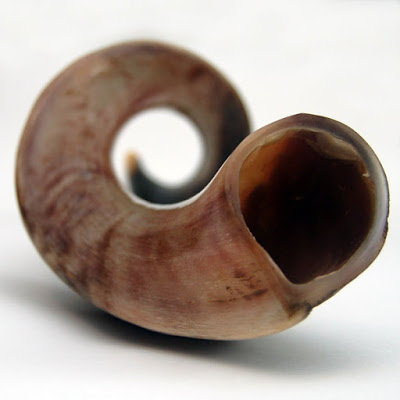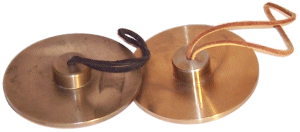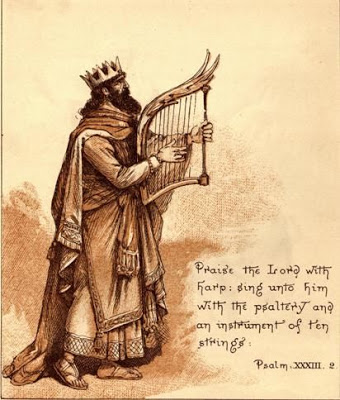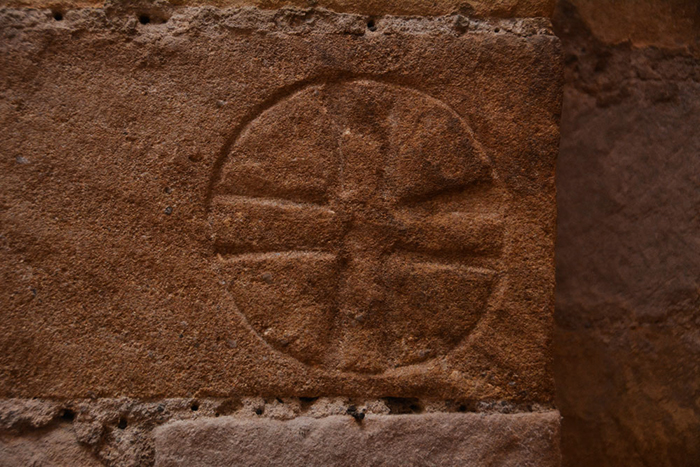
 Shofar
Shofar
“My bowels, my bowels, I writhe in pain! The chambers of my heart are throbbing! My heart moans within me! I cannot keep quiet for I have heard the voice of shofar, the shout of war.” – Jeremiah 4:19
Shofar is a non-musical signaling device made from the hollow horn of an animal and in some cases, specifically the horn of a ram. The shofar is played by buzzing the lips on the small end of an animal horn that has been cut, pierced and smoothed. As the range of an average size shofar consists of only a few playable tones, the calls that were used consisted of varying sequences of long and short tones.
Where it is mentioned in the Bible: Exodus 19:16, 19:19, 20:18 (20:15 JPS); Leviticus 25:9 (2x); Joshua 6:4 (2x), 6:5, 6:6, 6:8 (2x), 6:9 (2x), 6:13 (3x), 6:16, 6:20, 6:20; Judges 3:27, 6:34, 7:8, 7:16, 7:18, 7:18, 7:19, 7:20 (2x), 7:22; 1 Samuel 13:3, 2 Samuel 2:28, 6:15, 15:10, 18:16, 20:1, 20:22; 1 Kings 1:34, 1:39, 1:41; 2 Kings 9:13.
 Cymbals
Cymbals
From the limited context within the Scriptures, this type of cymbal, briefly mentioned in 2 Samuel 6:5 and Psalm 150:5, most likely corresponded to the smaller variety of ancient cymbals found on cymbal clappers and the finger cymbals associated with Middle Eastern dance.
It is type of concussion instrument consisting of two small cymbal plates attached to a pronged, u-shape handle that when rapidly shaken causes the plates to concussively strike each other creating the rapidly oscillating rhythm referred to in the Hebrew texts as the teruah. Cymbal clappers are referred to in contemporary music as a cymbal castanets.
Where it is mentioned in the Bible: 2 Samuel 6:5; Psalm 150:5
Bells
“And they made bells of pure gold and put the bells between the pomegranates on the hems of the robe round about, between the pomegranates:” – Exodus 39:25
Bells mentioned briefly in the book of Exodus; the bells (made of gold)were bell-like or clam-shell ornaments sewn on the hem of the priestly robe of Aaron between decorative pomegranates. Inside the bell was most likely a clapper or small pebble that would strike the bell casing creating a tinkling sound that could be heard when the bell was shaken or excited. Although considered as a percussion instrument and an instrumental sound effect today (e.g., jingle bells), the gold bells of the Hebrew texts refer specifically to one and only one non-musical usage; to act as some type of warning signal that was used to prevent the accidental death of Aaron or his sons (i.e., the priests)when entering or leaving the chamber of the Most Holy.
Where it is mentioned in the Bible: Exodus 28:33, 28:34 (2x), 39:25 (2x), 39:26 (2x)
 Wooden Clappers
Wooden Clappers
Wooden Clappers by implication of the single text found in 2 Samuel 6:5 “with all kinds of cypress wood” may refer to instruments like the wooden clappers and rhythm bones. The clappers originated as an ancient hunting implement and later as a rhythm instrument. The clappers had a semi-circular (boomerang) shape and were held (one in each hand) and struck concussively together to stir fowls from the underbrush. When the wildlife flew, the hunters would then throw the clappers at the birds to down them. As a rhythm instrument, the individual clappers were concussively struck together, providing a pronounced clack. 2 Samuel 6:5
Trumpets
“And YAHVEH spoke to Moses, saying, ‘Make two trumpets of silver. Make them out of a whole piece of beaten silver and use them for the calling of the assembly and for sounding the order to break camp'” Numbers 10:1-2
A pair of non-musical metal signaling devices used by the Levite priests to signal the breaking of camp, assembly and in conjunction with various ritual functions. Originally crafted as a pair out of a solid piece of beaten silver, the instruments consisted of a mouthpiece, a straight bore body terminating in a flared bell and measured about 45 cm (17.75″) from the bell to the mouthpiece. Like the shofar, sound is created by buzzing the lips on the mouthpiece while blowing. Also like the shofar, the calls of the two silver trumpets consisted of varying sequences of long and short tones.
Where it is mentioned in the Bible: Numbers 10:2, 10:8, 10:9, 10:10, 31:6; 2 Kings 11:14 (2x), 12:13 (12:14 JPS); Ezra 3:10; Nehemiah 12:35, 12:41; Hosea 5:8 (traditionally translated as a single trumpet – chä-tsots-rä’); Psalm 98:6; 1 Chronicles 13:8, 15:24, 15:28, 16:6, 16:42; 2 Chronicles 5:12, 5:13, 13:12, 13:14, 15:14, 20:28, 23:13 (2x), 29:26, 29:27, 29:28
Shakers/rattles
Small, handheld instruments used in celebrations and in conjunction with the dance. These simple instruments were most likely made of a hollow clay
shell with pebbles, stones or nuts inside that would rattle when shook (like a baby’s rattle). Contemporary instruments like shakers and maracas produce a sound that is somewhat, if not identical, to these rudimental concussion instruments and are still in common use today in Latin and popular music.
 Frame-drum
Frame-drum
“and Miriam took the frame-drum in her hand; and all the women went out after her with frame-drums and with dances” – Exodus 15:20
A large, thin drum, generally associated with female players, primarily used in secular celebrations and in conjunction with the dance. The frame-drum was held with the left hand and was played by striking the head of the drum with the alternating thumb and forefingers of the right hand in various rhythmic patterns.
Where it is mentioned in the Bible: Genesis 31:27; Exodus 15:20 (2x); Judges 11:34; 1 Samuel 10:5, 18:6; 2 Samuel 6:5; Isaiah 5:12, 24:8, 30:32; Jeremiah 31:4; Ezekiel 28:13 (a setting for jewelry); Nahum 2:7 (2:8 JPS); Psalm 68:25 (68:26 JPS), 81:2, 149:3, 150:4; Job 21:12; 1 Chronicles 13:8
Crotales
“and David spoke to the chiefs of the Levites to them appoint some of their brothers as singing men with instruments of song; harps, lyres and melodic cymbals for lifting up with the voice for joy” – 1 Chronicles 15:16
The melodic cymbals referenced in the Septuagint in Psalm 150:5 most likely refer to instruments similar to our modern day crotales. Exclusively referenced in relation to being played by the Levite singers, this larger variety of ancient cymbals (always referenced as a pair) were capable of producing defined pitches like our modern crotales. Tuned to the tones A and C, which correspond to the name of YAH and an A minor triad, the melodic cymbals of the Levites were used not only to give the starting pitches to the singers, but also to praise the Name of YAH.
Where it is mentioned in the Bible: Ezra 3:10; Nehemiah 12:17; 1 Chronicles 13:8, 15:16, 15:19, 15:28, 16:5, 16:42, 25:1, 25:6; 2 Chronicles 5:12, 5:13, 29:25
Rhythm Bones
By implication of the single text found in 2 Samuel 6:5 “with all kinds of cypress wood [instruments]” may refer to instruments like the wooden clappers and rhythm bones. Rhythm bones are a rudimental rhythm instrument consisting of two slightly curved pieces of wood, bone or ivory that were held in one hand and rhythmically struck together. Played in a manner similar to the playing of spoons, the bones also provided a rhythmic backdrop to the dance.
Where it is mentioned in the Bible: 2 Samuel 6:5
Reed-Pipe
“after that, you are to come to the hill of the God, where the garrison of the Philistines is. And it will occur as you come into the city, that you are going to meet a group of prophets coming down from the high place, harp and frame-drum and reed-pipe and lyre before them, and they will be prophesying” – 1 Samuel 10:5
Possibly a type of woodwind instrument of the double-reed category with a nasal, piercing tone like modern oboes and English horns. Due to the exciting flavor and timbre of the instrument and its distinctive modes, the reed-pipe was a popular instrument of the people and was used extensively in celebrations. Its unique ability to transmit emotion also made it a staple sound at funerals where it could emulate the plaintive wailing and sorrow of the mourners. Most likely a direct cousin of the the Arabic mizmar still in use today in conjunction with traditional dance and celebrations.
Where it is mentioned in the Bible: 1 Samuel 10:5; 1 Kings 1:40 (2x); Isaiah 5:12, 30:29; Jeremiah 48:36 (2x); Malachi 1:12 ( profane), Psalm 87:7
Cymbals
From the limited context within the Scriptures, this type of cymbal, briefly mentioned in 2 Samuel 6:5 and Psalm 150:5, most likely corresponded to the smaller variety of ancient cymbals found on cymbal clappers and the finger cymbals associated with Middle Eastern dance.
Where it is mentioned in the Bible: 2 Samuel 6:5; Psalm 150:5
Lyre
“Play to YAHVEH with lyre and the sound of a melody” – Psalm 98:5
An ancient type of stringed instrument used to accompany the voice or as a solo melodic instrument. With at least seven or possibly eight strings, the lyre was primarily considered a chording instrument in relation to the musical performances of the Levites providing the harmonic support for the singers and the harps.
Where it is mentioned in the Bible: Genesis 4:21, 31:27; 1 Samuel 10:5, 16:16, 16:23; 2 Samuel 6:5; 1 Kings 10:12; Isaiah 5:12, 16:11, 23:16, 24:8, 30:32; Ezekiel 26:13; Psalm 33:2, 43:4, 49:4 (49:5 JPS), 57:8 (57:9 JPS), 71:22, 81:2 (81:3 JPS), 92:3 (92:4 JPS), 98:5 (2x), 108:2 (108:3 JPS), 137:2, 147:7, 149:3, 150:3; Job 21:12, 30:31; Nehemiah 12:27; 1 Chronicles 13:8, 15:16, 15:28, 15:21, 16:5, 25:1, 25:3, 25:6; 2 Chronicles 5:12, 9:11, 20:28, 29:25

Harp
“Oh God, a new song I will sing to You. With a harp of ten [strings] I will play to You” – Psalm 144:9
An ancient string instrument of ten strings used to accompany the voice. Standing almost three feet tall, the harp had of two sets of strings (five on each side of the instrument) that could be played in much the same manner as modern harps (by plucking with the fingers) or possibly with a bow. The harp was primarily a melodic instrument and most likely doubled or outlined the melodies sung by the singers.
Where it is mentioned in the Bible: 1 Samuel 10:5; 2 Samuel 6:5; 1 Kings 10:12; Isaiah 5:12, 14:11; Amos 5:23, 6:5; Psalm 33:2, 57:8 (58:9 JPS), 71:22, 81:2 (81:3 JPS), 92:3 (92:4 JPS), 108:2 (108:3 JPS), 144:9, 150:3; Nehemiah 12:27; 1 Chronicles 13:8, 15:16, 15:20, 15:28, 16:5, 25:1, 25:6; 2 Chronicles
5:12, 9:11, 20:28, 29:25





These instruments are new name for me. They are old musical instrument at the tie of Bible. Are they still being played in any part of world? I
This is a good post. This post gives truly quality information. I’m definitely going to look into it. Really very useful tips are provided here. Thank you so much. Keep up the good works. click here
This is a high-quality article with a lot of information. The instruments mentioned in the Bible are strange to me, but I want to study them.